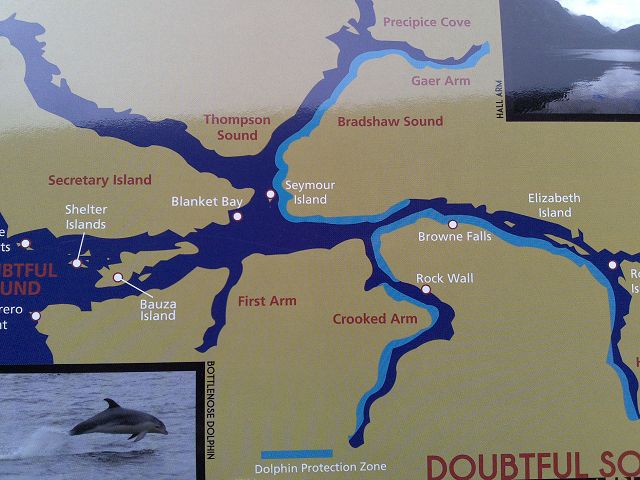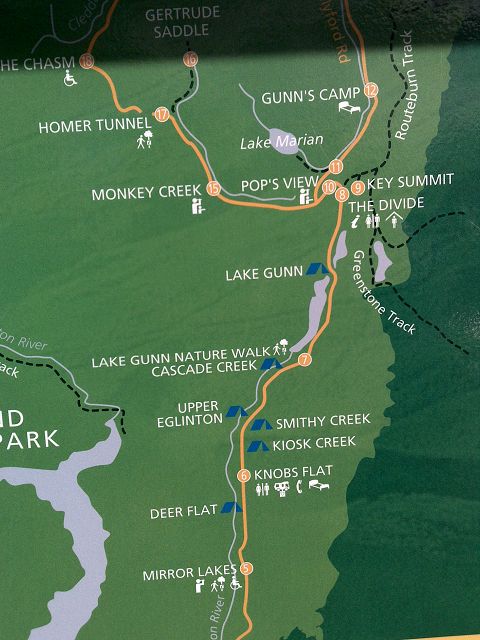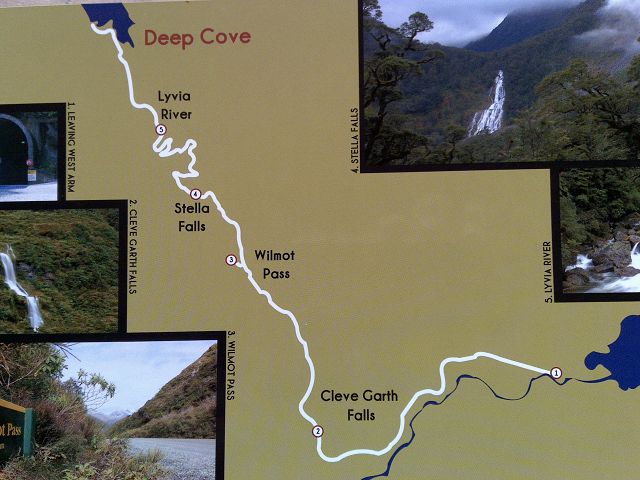Der Doubtful Sound ist wohl etwas zu Unrecht bei
den meisten Besuchern die zweite Wahl nach dem Milford Sound, zumal er sich
durchaus von diesem unterscheidet. Die Berge sind ähnlich hoch, außerdem ist
der Fford stark verzweigt, abwechslungsreicher und überaus grün. Er wird von
Delphinen, Pinguinen und Robben bewohnt, die sich im Laufe einer Bootstour
gut beobachten lassen.
Durch die starken Regenfälle liegt eine mehrere Meter dicke
Süßwasserschicht, die durch die ausgewaschenen Pflanzenreste Licht
absorbiert, auf dem Meerwasser. Daher finden sich hier Korallen, die
normalerweise nur in größeren Tiefen anzutreffen sind, bereits wenige Meter
unter der Wasseroberfläche.
Lake Manapouri is one of the most beautiful and pristine lakes in
New Zealand, located in the
South Island in the
Fiordland region. It is
known for its deep blue waters, stunning scenery, and tranquil environment.
The lake is often referred to as the "most beautiful lake in New Zealand"
due to its remote setting amidst towering mountains and ancient forests.
Key Features of
Lake Manapouri:
1.
Geography and Location
-
Location: Lake
Manapouri is situated in the
Fiordland National Park, approximately
20 kilometers (12 miles)
from the small town of Te Anau,
which serves as the closest access point. It is nestled in the
southwestern part of the South Island.
-
Size: It is the
second-largest lake in
New Zealand by surface area (after
Lake Taupo) and the
deepest lake in New
Zealand, with a maximum depth of about
444 meters (1,460 feet).
-
Formation: Like many
other lakes in Fiordland, Lake Manapouri was formed by glacial activity
during the last ice age, creating its deep, U-shaped valleys and rugged
landscapes.
2.
Scenic Beauty
-
Crystal-Clear Waters:
The lake’s waters are incredibly clear, reflecting the surrounding
snow-capped mountains
and dense forests.
The vivid blue color of the lake is attributed to the purity of the
water, with minimal human intervention in the region.
-
Fiordland Mountains:
Lake Manapouri is surrounded by the
Fiordland Mountains,
including towering peaks such as
Mount Titiroa and
Mount Kepler. The
lake offers breathtaking views of these dramatic, alpine landscapes.
-
Remote and Tranquil:
The lake is relatively isolated, offering a peaceful retreat away from
the crowds. The setting feels almost untouched by human development,
with vast wilderness areas surrounding the lake.
3.
Outdoor Activities
-
Cruises and Boat Tours:
One of the most popular activities on Lake Manapouri is taking a
boat cruise to
explore its shores and enjoy the stunning scenery. Several operators
offer guided tours, and some cruises also combine visits to nearby areas
like Doubtful Sound.
-
Doubtful Sound Cruise:
The Doubtful Sound
cruise is one of the highlights of the area. From Lake Manapouri, a
short boat ride takes visitors to
Doubtful Sound, a
remote and serene fiord. The cruise offers spectacular views of
waterfalls, rainforests, and wildlife such as dolphins and seals.
-
Kayaking and Canoeing:
The lake is also popular for
kayaking and canoeing.
Paddling on the calm, crystal-clear waters is a peaceful way to
experience the beauty of the lake and surrounding wilderness.
-
Fishing: Lake
Manapouri is home to several species of freshwater fish, including
rainbow trout and
brown trout, making
it a great spot for fishing. The lake's remote nature ensures a quiet
and undisturbed fishing experience.
-
Hiking and Tramping:
The surrounding Fiordland
National Park offers a variety of hiking and walking
opportunities, including tracks like:
-
Kepler Track: One
of New Zealand's Great Walks, the
Kepler Track is a
multi-day hike that loops around the lake and offers stunning
panoramic views of the lake, mountains, and nearby areas.
-
Borland Road: For
those interested in a more moderate hike, the
Borland Road
offers scenic views of the lake and the surrounding forest.
4.
Manapouri Power Station
-
Hydroelectric Power:
Lake Manapouri is also home to the
Manapouri Power Station,
a major hydroelectric power station that is located at the southern end
of the lake. The power station generates electricity for New Zealand,
and the project involved the construction of tunnels beneath the
mountains to divert water.
-
Controversy: The
development of the power station in the 1960s was controversial due to
its environmental impact. The construction required the lake's water
level to be lowered, which led to significant concerns from
environmentalists and local communities.
5.
Wildlife and Flora
-
Birdlife: The region
surrounding Lake Manapouri is home to a wide variety of native bird
species, including the
yellow-eyed penguin,
keas, and fantails.
The area is a haven for birdwatchers.
-
Native Forests: The
lush forests around the lake are dominated by
beech trees,
podocarps, and other
native flora. The forests are dense and provide an incredible backdrop
to the lake's beauty.
6.
Access and Transportation
-
By Car: Lake
Manapouri is about a 15-20 minute drive from
Te Anau, which is the
nearest town with accommodations, services, and transport links. Te Anau
is approximately 2 hours' drive from
Queenstown or
Invercargill.
-
By Boat: To reach
some parts of the lake, you’ll need to take a boat or cruise, as much of
the shore is rugged and inaccessible by car.
-
By Plane: For those
seeking a unique experience, there are small plane flights available
from Te Anau that
offer aerial views of the lake, surrounding mountains, and Fiordland
National Park.
7.
Best Time to Visit
-
Summer (December to February):
The summer months are the most popular time to visit, with warm
temperatures and clear skies perfect for outdoor activities like hiking,
boating, and kayaking.
-
Autumn (March to May):
Early autumn offers cooler weather and fewer tourists, making it a great
time to visit if you prefer a quieter experience while still enjoying
beautiful fall colors in the surrounding forests.
-
Winter (June to August):
The winter months are colder, with snow-capped mountains creating a
beautiful, serene atmosphere. While it can be chilly, it’s a peaceful
time to visit if you’re looking for tranquility and a chance to
experience the area’s winter beauty.
Conclusion:
Lake Manapouri is a
stunning natural gem in Fiordland
National Park, offering breathtaking scenery, outdoor adventure,
and a sense of serenity. Whether you’re exploring the lake by boat, hiking
through the wilderness, or simply relaxing by its shores, the area provides
an unforgettable experience. The surrounding mountains, forests, and
wildlife add to its allure, making it a must-visit destination for anyone
traveling to the South Island of
New Zealand.
|
Die Anreise zum Doubtful Sound erfolgt - wenn
nicht zu Fuß - über eine kombinierte Bus- und Schiffstour von Manapouri aus.
Zunächst überquert man den gleichnamigen See, bevor man mit dem Bus über den
Wilmot Pass auf die andere Seite der Berge gefahren wird. Dort schließt sich
die Rundtour durch den Fiord an, bevor auf der Rückreise noch das
Wasserkraftwerk am Lake Manapouri besucht wird. Die Straße über die Berge
sowie die Pier im Fjord sind für den Bau und Betrieb dieses Kraftwerks
angelegt worden.
Doubtful Sound is one of the most beautiful and remote fiords in
Fiordland National Park,
located in the South Island
of New Zealand. It is
renowned for its dramatic landscapes, stunning natural beauty, and tranquil,
untouched wilderness. Due to its location and relative inaccessibility,
Doubtful Sound remains much
less crowded compared to other fiords in New Zealand, making it a serene and
peaceful destination for those seeking an escape into nature.
Key Features of
Doubtful Sound:
1.
Scenic Beauty and Geography
-
Fiordland: Doubtful
Sound is part of Fiordland
National Park, a UNESCO World Heritage Site, and is one of the
most pristine and awe-inspiring locations in the country. The sound
stretches over 40 kilometers
(25 miles) and is surrounded by
towering mountains, dense rainforests, and cascading
waterfalls.
-
Size and Depth:
Doubtful Sound is a
vast fiord, much larger and deeper than its more famous counterpart,
Milford Sound. It
reaches a maximum depth of 421
meters (1,381 feet), making it one of the deepest fiords in New
Zealand.
-
Isolation: The sound
is incredibly remote and is often less visited than
Milford Sound due to
its inaccessibility by road. This contributes to its tranquility and
pristine environment.
2.
Access and Transportation
-
By Boat: One of the
best ways to explore Doubtful
Sound is by boat. A scenic
cruise allows you to
get close to the water’s edge and explore the fiord's beauty. The trip
typically starts from
Manapouri (a small town near Lake Manapouri) and involves a
boat ride across Lake Manapouri, followed by a bus ride through the
Wilmot Pass (the only
road access to the fiord) before boarding a larger cruise boat to
explore Doubtful Sound.
-
Wilmot Pass: The
Wilmot Pass is a
narrow mountain road that leads to the fiord and offers incredible views
of the surrounding landscapes, including the lush rainforests and steep
hillsides.
-
By Air: For a unique
perspective, some tour operators offer scenic flights over
Doubtful Sound,
providing breathtaking aerial views of the fiord and surrounding
mountains.
3.
Wildlife
-
Dolphins:
Doubtful Sound is
known for its population of
Dusky Dolphins, which are frequently seen swimming and playing
around boats. These dolphins are highly social and are a highlight for
many visitors.
-
Seals: The fiord is
also home to large populations of
New Zealand fur seals,
which can be spotted sunbathing on rocks or swimming in the waters.
-
Birdlife: The area is
home to a variety of bird species, including the
kea (a large, green
alpine parrot), the south
island saddleback, and the
shags (a type of
cormorant). Birdwatchers will be delighted by the variety of species
found in this remote region.
-
Penguins:
Occasionally, you can spot
yellow-eyed penguins or
fiordland crested penguins,
although sightings are rare and usually happen in more isolated parts of
the fiord.
4.
Doubtful Sound Cruises
-
Full-Day Cruises:
Many of the available cruises are full-day tours that include both
scenic boat rides and a stopover for a closer look at the wilderness.
Some cruises offer opportunities for activities such as kayaking, which
allows you to paddle through the fiord and experience its tranquility up
close.
-
Overnight Cruises:
For a more immersive experience, there are
overnight cruises
available that allow you to spend more time exploring the fiord. These
cruises typically include onboard accommodation, meals, and activities
like fishing or kayaking.
-
Kayaking: Kayaking is
a popular way to explore
Doubtful Sound in a more intimate way. Some tour operators
offer guided kayaking trips, where you can paddle along the fiord’s
peaceful waters and explore areas that aren’t accessible by boat.
5.
Waterfalls and Scenic Features
-
Waterfalls:
Doubtful Sound is
home to several spectacular waterfalls, especially after rainfall, when
the mountainsides come alive with cascading water. The
Bowen Falls is the
most famous waterfall in the area, and there are numerous smaller
waterfalls along the way.
-
Rainforests: The
fiord’s steep cliffs are covered with lush temperate rainforests, which
provide a stunning contrast to the rugged landscapes and clear blue
waters. These rainforests are part of one of the most biodiverse
ecosystems in New Zealand.
6.
The Sound’s History
-
Naming: The fiord was
named Doubtful Sound
by the British explorer
Captain James Cook in
1770 during his voyage around New Zealand. Cook initially
doubted whether he could navigate the fiord safely, which is how it got
its name. However, today it is one of the most celebrated natural
wonders in the country.
-
Maori Significance:
The fiord has cultural significance to the Māori people, who
historically used the area for fishing, travel, and settlement. The
Māori name for Doubtful Sound is
Patea, which is
believed to refer to a storm or rough weather, possibly alluding to the
challenges of navigating the fiord in earlier times.
7.
Environmental Conservation
-
Fiordland National Park:
As part of the larger
Fiordland National Park, Doubtful Sound is protected and
preserved in its natural state. The park is one of the largest national
parks in New Zealand and is part of the
Te Wahipounamu World
Heritage Area, recognized for its outstanding universal value due to its
natural beauty and ecological importance.
-
Conservation Efforts:
Conservation efforts in the area aim to protect the fragile ecosystems
of the fiord, including the forests, native species, and freshwater
habitats. Visitors are encouraged to respect the natural environment and
follow Leave No Trace principles.
8.
Best Time to Visit
-
Summer (December to February):
The summer months offer warmer temperatures and longer days, making it
the most popular time to visit. During this time, the weather is
generally calm and pleasant for cruises and outdoor activities.
-
Autumn (March to May):
Autumn is a quieter time to visit, with fewer tourists, and the cooler
weather creates a misty, atmospheric effect over the fiord. It’s an
excellent time for those looking to experience Doubtful Sound in a more
peaceful setting.
-
Winter (June to August):
Winter brings colder temperatures, and the fiord can look even more
dramatic with snow-capped mountains. This is a peaceful time to visit if
you don’t mind the cold and want to experience the area in solitude.
-
Spring (September to November):
Spring offers a lovely combination of mild weather and beautiful scenery
as the snow starts to melt and the rainforest begins to bloom.
Conclusion:
Doubtful Sound is a
remote and pristine fiord that offers a peaceful and awe-inspiring escape
into nature. Its dramatic landscapes, abundant wildlife, and tranquil waters
make it a must-visit destination for those exploring
Fiordland National Park.
Whether you are cruising, kayaking, or simply enjoying the incredible views,
the serenity and natural beauty of Doubtful Sound will leave a lasting
impression.
|
 Safaris
Bergsteigen
Wandern
Inselwandern Weltweit
Safaris
Bergsteigen
Wandern
Inselwandern Weltweit
 Europa
Inselwandern
Europa
Inselwandern
 Städtewandern
Städtewandern
 Paintings
Paintings Dirk Rauschenbach
Dirk Rauschenbach
 Safaris
Bergsteigen
Wandern
Inselwandern Weltweit
Safaris
Bergsteigen
Wandern
Inselwandern Weltweit
 Europa
Inselwandern
Europa
Inselwandern
 Städtewandern
Städtewandern
 Paintings
Paintings Dirk Rauschenbach
Dirk Rauschenbach



![]() 26.07.25 Copyright Dirk
Rauschenbach Koelnerstrasse 293 51702 Bergneustadt
Datenschutzerklaerung 02261 9788972 Mail ccooly(
at) web.de
26.07.25 Copyright Dirk
Rauschenbach Koelnerstrasse 293 51702 Bergneustadt
Datenschutzerklaerung 02261 9788972 Mail ccooly(
at) web.de